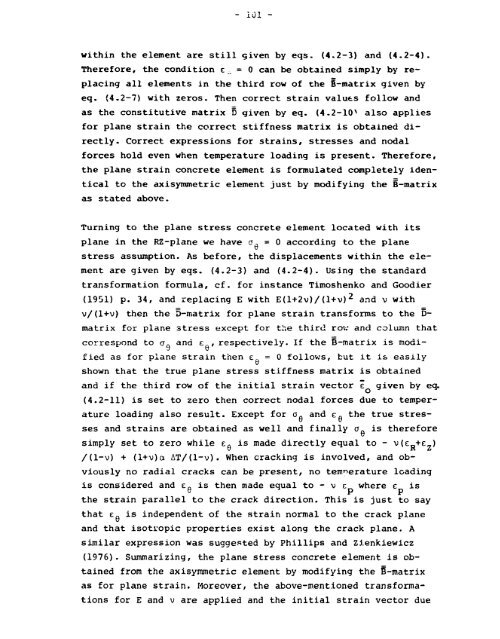Nonlinear Finite Element Analysis of Concrete Structures
Nonlinear Finite Element Analysis of Concrete Structures
Nonlinear Finite Element Analysis of Concrete Structures
Create successful ePaper yourself
Turn your PDF publications into a flip-book with our unique Google optimized e-Paper software.
- 101 -<br />
within the element are still given by eqs. (4.2-3) and (4.2-4).<br />
Therefore, the condition e = 0 can be obtained simply by replacing<br />
all elements in the third row <strong>of</strong> the B-matrix given by<br />
eq. (4.2-7) with zeros. Then correct strain values follow and<br />
as the constitutive matrix 5 given by eq. (4-2-10^ also applies<br />
for plane strain the correct stiffness matrix is obtained directly.<br />
Correct expressions for strains, stresses and nodal<br />
forces hold even when temperature loading is present. Therefore,<br />
the plane strain concrete element is formulated completely identical<br />
to the axisymmetric element just by modifying the B-matrix<br />
as stated above.<br />
Turning to the plane stress concrete element located with its<br />
plane in the RZ-plane we have a a = 0 according to the plane<br />
u<br />
stress assumption. As before, the displacements within the element<br />
are given by eqs. (4.2-3) and (4.2-4). Using the standard<br />
transformation formula, cf. for instance Timoshenko and Goodier<br />
(1951) p. 34, and replacing E with E(l+2v)/(l+v) 2 and v with<br />
v/(l+v) then the D-matrix for plane strain transforms to the D-<br />
matrix for plane stress except for the third rov» and column that<br />
correspond to c. and e , respectively. If the B-matrix is modified<br />
as for plane strain then e„ = 0 follows, but it is easily<br />
w<br />
shown that the true plane stress stiffness matrix is obtained<br />
and if the third row <strong>of</strong> the initial strain vector e given by eq.<br />
(4.2-11) is set to zero then correct nodal forces due to temperature<br />
loading also result. Except for ø fi and e fi the true stresses<br />
and strains are obtained as well and finally a« is therefore<br />
simply set to zero while e fl is made directly equal to - v(e +e )<br />
/(1-v) + (l+v)a AT/(l-v). When cracking is involved, and obviously<br />
no radial cracks can be present, no temperature loading<br />
is considered and e fi is then made equal to - v e where c is<br />
the strain parallel to the crack direction. This is just to say<br />
that e„ is independent <strong>of</strong> the strain normal to the crack plane<br />
and that isotropic properties exist along the crack plane. A<br />
similar expression was suggested by Phillips and Zienkiewicz<br />
(1976)- Summarizing, the plane stress concrete element is obtained<br />
from the axisymmetric element by modifying the B-matrix<br />
as for plane strain. Moreover, the above-mentioned transformations<br />
for E and v are applied and the initial strain vector due
















